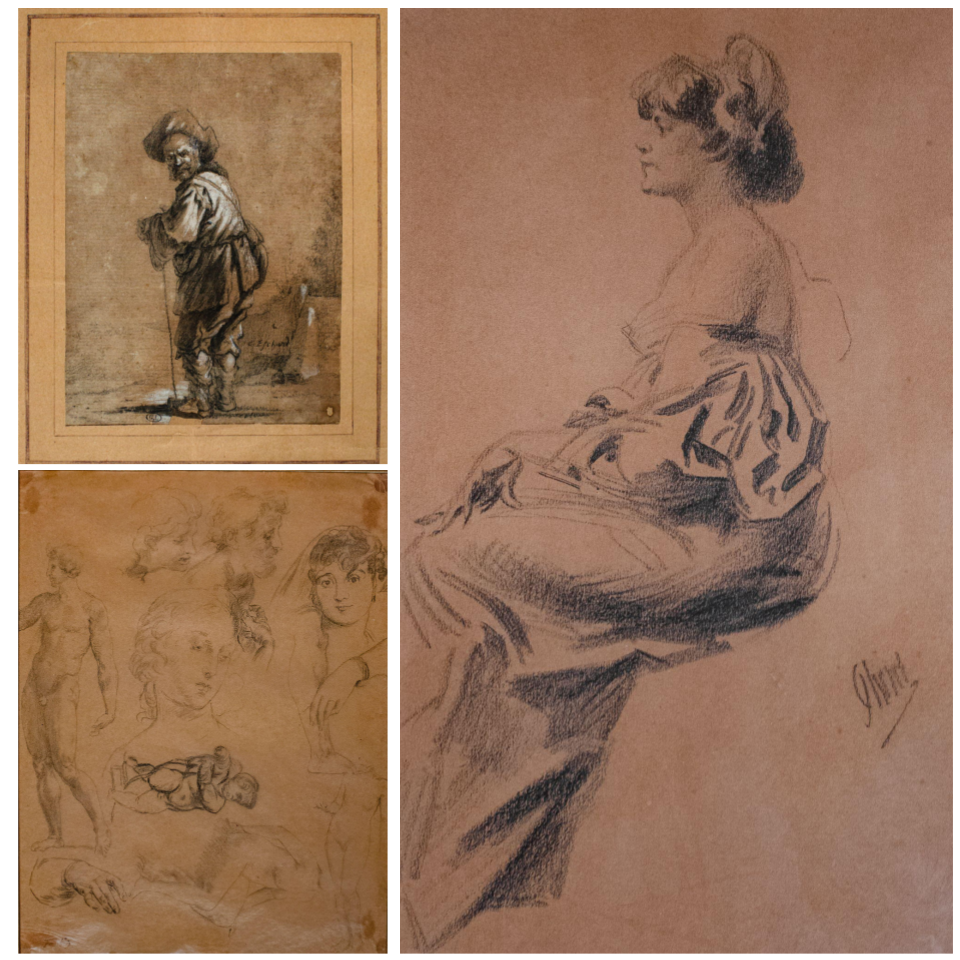
Artist: Henri-Théodore Fantin-Latour, Jules Chéret, Charles Eschard
Artist Nationality: French
Artist Dates:
Title: French Drawings by Charles Eschard, Henri-Théodore Fantin-Latou, Jules Chéret
Date: 17th century - 1900
Condition: See description
Medium: Drawings
Dimensions: See description
Estimated Value: $3,350
Signature/Markings: See description
Upper left:
Charles Eschard (French, 1748 - 1810)
Untitled (Portrait of a Beggar), 18th century
Pencil and pastel on paper
Sight: 6 ½ x 4 ¾ in.
Framed: 13 ¼ x 10 ¼ x ¾ in.
Artist stamp at bottom, signed right
Provenance: 4LBT, Toulouse, France
Condition: Some loss; small lack of paper on the foot formerly
restored (not examined outside of frame)
Value: $1,000
Charles Eschard was born in 1748 in Caen. Eschard became a French painter, draftsman and engraver. He began his artistic training at the Rouen Academy of Arts directed by Jean-Baptiste Descamps. He then spent a few years in Holland, where he studied the masterpieces of the Flemish masters from which he drew inspiration to perform his works. Some of his engravings are kept in the Philadelphia Museum.
Lower left:
Henri-Théodore Fantin-Latour (French, 1836-1904)
Untitled (Study), c. 19th century
Pencil drawing on tracing paper
Sight: 10 x 8 in.
Framed: 18 ½ x 15 x ½ in.
Signed lower left
Provenance: Antiquaire Art & Antics, Grenoble, FR
Condition: Glue spots from backing board visible at corners (not examined outside of frame)
Value: $1,350
Fantin-Latour started his artistic education with lessons from his father, Théodore Fantin-Latour. This instruction was followed by enrollment at the Ecole des Beaux Arts, and he later worked in the studio of Gustave Courbet. From 1853 for about 12 years, he made his living by copying Old Master paintings at the Louvre, where he made the acquaintance of Edgar Degas, Edouard Manet and Berthe Morisot. He became close friends with James McNeill Whistler - along with Whistler and Alphonse Legros, he helped to form the Société des Trois. In 1859, Whistler invited him to visit London; with Whistler's, Legros' and engraver Edwin Edwards' influence, he became a part of the sophisticated art society of London. In 1861 and 1862, he first exhibited at the Paris Salon. He had close friendships with Impressionists but did not participate in their exhibitions nor agree with their theories. His style was precise and realistic, and he was a great admirer of the Romantics including composer Richard Wagner, whose music he illustrated with lithographs.
Right:
Jules Chéret (French, 1836-1932)
Untitled (Belle Époque), 1900
Charcoal on paper
Sight: 14 x 9 in.
Framed: 21 ½ x 16 ½ x ¾ in.
Signed lower right
Provenance:
Monsieur Charles Roger McSwiggan
Fox Fine Art, Flintshire, UK (2020)
Condition: Good (not examined outside of frame)
Includes COA
Value: $1,000
Jules Cheret, who was a painter in oil and pastel as well as lithographer, was raised in Paris in a poverty level family of artisans. His schooling ended when he was age 13, and his father, who was a typographer, arranged a three-year apprenticeship with a lithographer, who could teach the young man what was then the prevailing method of design reproduction. Cheret did much research and experimentation with design processes, and in 1858, created his first poster, which was for the composer Jacques Offenbach. Frustrated with his lack of success to sell music-theme sketches to publishers, he worked in London in the 1860s to enhance his education. There he worked for The Maple Furniture Company and for Cramer, a publishing firm doing circus, theater and music-hall posters, but he was not happy with these experiences. In 1866, Cheret returned to Paris, opened a studio and began the creative method of printing theatrical posters that made images seem vital and three dimensional, attracting wide public acclaim with their vivid colors. He also incorporated much text into his posters, which was an innovation. He executed many drawings throughout his career, some of which were preparatory and others simply works in their own right.
Provenance:
See description
Exhibition History:
N/A
Publication History:
N/A